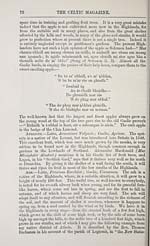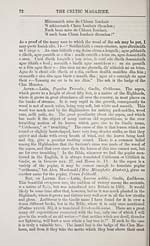Blair Collection > Celtic magazine > Volume 4
(81)
Download files
Complete book:
Individual page:
Thumbnail gallery: Grid view | List view

THE CELTIC MA.GAZINE. 71
tical Account of Scotland" (1844). He says — "There is a remarkable
ash tree in the innkeeper's garden, near the village of Logierait. It
measures at the ground 53^ feet in circumference ; at three feet from the
ground, 40 feet ; and at eleven feet from the ground, 22 feet. The height
60 feet ; but the upper part of the stem appears to have been carried
away. The height is said to have been at one time nearly 90 feet. The
trunk is hollow from the base, and can contain a large party. This
venerable stem is surmounted by a profusion of foliage, which, even at
the advanced age of the tree, attracts the eye at a distance to its uncom-
mon proportions. An old man at the age of 100 is at present in the
habit of taking his seat daily within the hoUow formed by its three
surviving sides — iio unsuitable companion to the venerable relic." In
the same work, in the accounts of the parishes of Kenmore and Weem,
liiention is made of an ash in the park of Taymouth Castle, 18 feet in
circumference, aud other tAvo on the lawn at Castle Menzies, 16 feet.
The wood of the ash, Avhich is hard and very tough, was much used by
the old Highlanders for making agricultural implements, handles for axes,
&c. Kesides those peaceful uses to Avhich they put the ash, they also
used it for warlike purposes, by making bows of it when yew could not
be had, and also for making handles for their spears and long Lochaber
axes. The Higlilanders have many curious old superstitions about the ash,
one of which is also common in some parts or the Lowlands, viz.: — That
the oak and the ash fortell whether it is to be a wet or a cby season, by
whichever of them comes first into leaf — if the ash comes first into leaf,
it is to be a very wet summer ; but very dry if the oak comes first. An-
other curious old superstition is still lingering in some parts of the High-
lands about the virtue of the sap for newly-born children, and as Light-
foot mentions it as common in the Highlands and Islands when he
travelled there witli Pennant, in 1772, I may give it in his words. He
says : — " In many parts of the Highlands, at the birth of a child, the
nurse or midwife, from what motive I know not, puts the end of a green
stick of ash into the fire, and, Avhile it is burning, receives into a spoon
the sap or juice which oozes out at the other end, and administers this as
the first spoonful of liquors to the newborn babe." Another old High-
land belief is that a decoction of the tender tops or leaves of the ash taken
inwardly, and rubbed outwardly to the Avound, is a certain cure for the
bite of an adder or serpent, and that an adder has such an antipathy to
the ash that if it is encompassed Avith ash leaves and twigs, it will rather
go through fire than through the ash.
" Theid an nathair troimh an teine dhearg,
Mu'n teid i troimh dhuilleach an uinnsinn."
In fact, the adders were supposed to regard the ash amongst the forest
trees as they did the M'lvors among the Highland clans ! Every High-
lander knows the old saying about the IMTvors and the adders —
Latha na Feill'-Bride
Their an nathair anns an torn —
" Cha bhi mise ri Nic-lomliair
'S cha bhi Nic-Iomhair rium!
tical Account of Scotland" (1844). He says — "There is a remarkable
ash tree in the innkeeper's garden, near the village of Logierait. It
measures at the ground 53^ feet in circumference ; at three feet from the
ground, 40 feet ; and at eleven feet from the ground, 22 feet. The height
60 feet ; but the upper part of the stem appears to have been carried
away. The height is said to have been at one time nearly 90 feet. The
trunk is hollow from the base, and can contain a large party. This
venerable stem is surmounted by a profusion of foliage, which, even at
the advanced age of the tree, attracts the eye at a distance to its uncom-
mon proportions. An old man at the age of 100 is at present in the
habit of taking his seat daily within the hoUow formed by its three
surviving sides — iio unsuitable companion to the venerable relic." In
the same work, in the accounts of the parishes of Kenmore and Weem,
liiention is made of an ash in the park of Taymouth Castle, 18 feet in
circumference, aud other tAvo on the lawn at Castle Menzies, 16 feet.
The wood of the ash, Avhich is hard and very tough, was much used by
the old Highlanders for making agricultural implements, handles for axes,
&c. Kesides those peaceful uses to Avhich they put the ash, they also
used it for warlike purposes, by making bows of it when yew could not
be had, and also for making handles for their spears and long Lochaber
axes. The Higlilanders have many curious old superstitions about the ash,
one of which is also common in some parts or the Lowlands, viz.: — That
the oak and the ash fortell whether it is to be a wet or a cby season, by
whichever of them comes first into leaf — if the ash comes first into leaf,
it is to be a very wet summer ; but very dry if the oak comes first. An-
other curious old superstition is still lingering in some parts of the High-
lands about the virtue of the sap for newly-born children, and as Light-
foot mentions it as common in the Highlands and Islands when he
travelled there witli Pennant, in 1772, I may give it in his words. He
says : — " In many parts of the Highlands, at the birth of a child, the
nurse or midwife, from what motive I know not, puts the end of a green
stick of ash into the fire, and, Avhile it is burning, receives into a spoon
the sap or juice which oozes out at the other end, and administers this as
the first spoonful of liquors to the newborn babe." Another old High-
land belief is that a decoction of the tender tops or leaves of the ash taken
inwardly, and rubbed outwardly to the Avound, is a certain cure for the
bite of an adder or serpent, and that an adder has such an antipathy to
the ash that if it is encompassed Avith ash leaves and twigs, it will rather
go through fire than through the ash.
" Theid an nathair troimh an teine dhearg,
Mu'n teid i troimh dhuilleach an uinnsinn."
In fact, the adders were supposed to regard the ash amongst the forest
trees as they did the M'lvors among the Highland clans ! Every High-
lander knows the old saying about the IMTvors and the adders —
Latha na Feill'-Bride
Their an nathair anns an torn —
" Cha bhi mise ri Nic-lomliair
'S cha bhi Nic-Iomhair rium!
Set display mode to: Large image | Transcription
Images and transcriptions on this page, including medium image downloads, may be used under the Creative Commons Attribution 4.0 International Licence unless otherwise stated. ![]()
| Early Gaelic Book Collections > Blair Collection > Celtic magazine > Volume 4 > (81) |
|---|
| Permanent URL | https://digital.nls.uk/76553306 |
|---|
| Description | Volume IV, 1879. |
|---|---|
| Shelfmark | Blair.5 |
| Attribution and copyright: |
|
| Description | A selection of books from a collection of more than 500 titles, mostly on religious and literary topics. Also includes some material dealing with other Celtic languages and societies. Collection created towards the end of the 19th century by Lady Evelyn Stewart Murray. |
|---|
| Description | Selected items from five 'Special and Named Printed Collections'. Includes books in Gaelic and other Celtic languages, works about the Gaels, their languages, literature, culture and history. |
|---|

